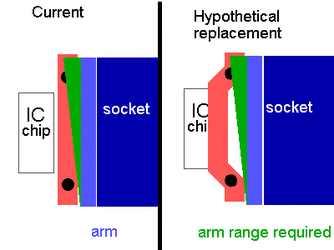Recently I reviewed the new Aquajoe block. Mr B also reviewed the block too and I found that while we compared them to two different blocks that we were using prior to getting the Aquajoe block we did draw similar conclusions in many ways. Here's Mr B's review, and this is mine. (addendum: I just noticed JoeC's formal testing of the block) Anywho I've already received one email asking about the home made barbs I had in my Swiftech block and while they are custom made they were made for me, not by me, so I asked my friend who made them just what he did to make them and here's his response for anyone else who's interested in trying to make their own: (I want to preface his response by saying to those outside Canada that "Canadian Tire" is a hardware store that sells more than just tires.)

So that's how the barbs for the Swiftech that went head to head with the Aquajoe block were made, If anyone's got any other questions about what was in my review feel free to ask.First, I started by searching the shelves at Canadian Tire, till I found some 3/8 pipe couplings. These are 1/2 inch ID, and slightly over 9/16 OD. I also purchased a pair of 3/8 NPT (National Pipe Thread) barbs.
The key is to work slowly, and have a drill press and appropriate vice. I clamped a barb into the vice with the barbed end down, then selected a drill bit that wouldn't quite fit through it. I then drilled (slowly) through it all, stepping the drill sizes up by 1/64 in with every pass.
The fun part was when I got over 1/2 IN, because I had to borrow drill bits from work. We didn't have a complete range in these sizes, so I had to take larger steps.
Once the barb part was completely separated from the body of the threads, I turned the part over in the vice. Care must be taken to be sure that the unit is as level as possible. What I did was to use the drill bits as guides by chucking the largest bit that would enter the hole, lowering the drill until whole assembly was at a solid height to clamp and then closed the vice. I then changed the drill up, and continued drilling.
Doing it the way I did it will take a while, but I wanted to see if it was possible without a machine-shop full of tools. I don't know that it would be possible with just a hand drill, but it would be totally out of the question without a solid vice.
Anyway, working from the top, I was careful not to drill all the way through the threaded unit, since I wanted a shoulder at the bottom of the bore. What I ended up with was a hole size that required me to press the 3/8 union into the threaded portion. At this point I cursed a bit and managed to take it apart again, remembering on the second try to slather everything with soldering paste. After assembling the parts again, it was a simple matter to fire up my brazing torch and solder the whole thing solidly together. After it cooled, I filed off the biggest lumps of unnecessary solder and buffed everything with ScotchBrite to make it shiny.
